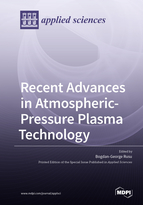Recent Advances in Atmospheric-Pressure Plasma Technology
A special issue of Applied Sciences (ISSN 2076-3417). This special issue belongs to the section "Materials Science and Engineering".
Deadline for manuscript submissions: closed (30 June 2022) | Viewed by 36755
Special Issue Editor
Interests: surface characterization; plasma deposition; atmospheric pressure plasmas; plasma diagnosis; atmospheric pressure plasma surface interactions; laser ablation; plasma agriculture
Special Issues, Collections and Topics in MDPI journals
Special Issue Information
Dear Colleagues,
Recently, various plasma sources, especially at atmospheric pressure, have been developed for different application such as the food industry, the textile industry, related environmental fields, and medical and agricultural applications. Due to the free electric charge particles that form, the plasma has a huge advantage in modifying surfaces at the nanometer level. Plasma treatment of the polymer surfaces can cause an increase in polar functional groups by breaking the polymeric chains, leading to the formation of free radicals which can react with the gases supplied to the plasma chamber. If, in addition to the working gas, other reactive gases or monomer groups are used, the surface changes can lead to the desired applications.
Atmospheric-pressure plasma can activate the vitality of seeds without causing gene mutations and also improve the growth and yield of plants. Associated with the promotion of growth, the plants also present resistance to biotic and abiotic stress, which is particularly important in their development. Applications of plasma physics technology in agriculture are increasingly popular, and cold plasma seed treatment is a modern eco-agricultural technology that has been suggested to stimulate plant growth. In medicine, some sources are already applied for the inactivation and sterilization of microorganisms.
As Guest Editors of this Special Issue of Applied Sciences, “Recent Advances in Atmospheric-Pressure Plasma Technology”, authors are invited to submit original research contributions dealing with atmospheric-pressure plasma. The topics of interest for this Special Issue include, but are not limited to, the following: plasma diagnostics, plasma material processing, plasma agriculture, plasma medicine, nanomaterials, plasma polymerization, simulation of atmospheric-pressure plasma phenomena.
Dr. Bogdan-George Rusu
Guest Editor
Manuscript Submission Information
Manuscripts should be submitted online at www.mdpi.com by registering and logging in to this website. Once you are registered, click here to go to the submission form. Manuscripts can be submitted until the deadline. All submissions that pass pre-check are peer-reviewed. Accepted papers will be published continuously in the journal (as soon as accepted) and will be listed together on the special issue website. Research articles, review articles as well as short communications are invited. For planned papers, a title and short abstract (about 100 words) can be sent to the Editorial Office for announcement on this website.
Submitted manuscripts should not have been published previously, nor be under consideration for publication elsewhere (except conference proceedings papers). All manuscripts are thoroughly refereed through a single-blind peer-review process. A guide for authors and other relevant information for submission of manuscripts is available on the Instructions for Authors page. Applied Sciences is an international peer-reviewed open access semimonthly journal published by MDPI.
Please visit the Instructions for Authors page before submitting a manuscript. The Article Processing Charge (APC) for publication in this open access journal is 2400 CHF (Swiss Francs). Submitted papers should be well formatted and use good English. Authors may use MDPI's English editing service prior to publication or during author revisions.
Keywords
- plasma diagnostics
- plasma material processing
- plasma agriculture
- plasma medicine
- nanomaterials
- plasma polymerization
- simulation of atmospheric-pressure plasma phenomena






